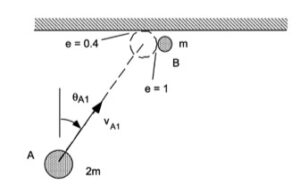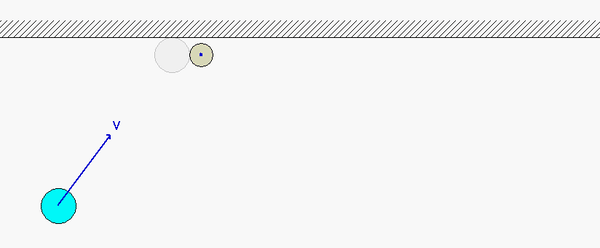| Problem statement Solution video |
DISCUSSION THREAD
NOTE: B is initially at rest when it is impacted by A.

Any questions?? Please ask/answer questions regarding this homework problem through the "Leave a Comment" link above.
Discussion and hints

The four-step solution procedure:
- Step 1 - FBDs: Draw individual free body diagrams (FBDs) for A and B, along with an FBD of A+B. Since you have two impacts occurring at the same time, identify the "n" direction for each impact (they are different for each impact).
- Step 2 - LIM and COR
- For the impact of A with the bumper, use the coefficient of restitution (COR) equation.
- For the impact of A with B, use conservation of linear momentum in the n-direction and the COR equation in the n-direction.
- Step 3 - Kinematics: None needed.
- Step 4 - Solve
Can we assume that B was initially at rest before coming in contact with A?
That is the assumption I made since it does not specify it directly.
Should our velocity for B be in vector or scaler form?
the hint says to identify the direction of n for both impacts, so when using e=0.4 to solve for Va_2, would I say that n is in the direction of the impact with sphere A and the bumper or in the direction of the impact with sphere A and B?
When visualizing this problem, I found it helpful to think of the bumper only effecting sphere A in the y direction and sphere B only effecting sphere A in the x direction. This allowed me to split up the problem into two different parts since they collide at the same time.
Yes, this is the key to the problem I believe as this direction you are describing is the "n" direction for each impact, which is the necessary information in order to use the COR equation as it depends on velocities in the "n" direction. This allows for analysis of the two impacts separately, based on their respective "n" direction, which is the direction normal to the impact (y-direction for bumper and A, and x-direction for A and B).
I also found this a tad confusing, but what I did set up my FBDs is to have the A+B FBD have two different coordinate systems (so two n and t axes labeled) to split up the problem to the impact between A and the bumper and the impact between A and B. Remember to have n in the orientation where it is parallel to the force applied.
For this problem, I found it really important to remember that the bumper has no velocity. This simplifies the equation for the coefficient of restitution between sphere A and the number and makes it easier to solve for Va_n2.
For this question, make sure to consider the system in three FBD's, from the perspective of A, from the perspective of B, and considering them both as a system. Also, keep in mind that the initial and final velocities of the bumper are zero.
When making the FBDs, since there are two impacts, do we draw two FBD for A alone considering the impact with B then with the bumper, or just draw one with A then draw the combined A+B FBD with respect to the bumper?
Yes, I drew two FBDs, one for each impact, this allows you to solve using the COR equation for the impact with the wall and then the COR and LIM equations for the impact with ball B.
When solving the problem, it is important to remember that the n and t directions are flipped for the impacts of A with the wall and A with B.
Make sure to write the velocities as vectors since A will have a y component (A with the bumper) and x component (A with B).
When making the free body diagrams, it does not seem very necessary to include separate FBDs for A and B individually when you only need to know information about two impacts. Would two FBDs of the system A + B work for setting up this problem, or would this method leave out important information?
It is always a good practice for ANY central impact problem to draw three FBDs: one by A alone, one for B alone and one for A+B. These FBDs help you keep straight in which directions linear momentum is conserved, and for which systems that these momenta are conserved. As is typical for these problems, you may not actually use the results for all six resulting components of momentum - but having all six visible helps keep you on the right track for solving.
A helpful example problem to look at from the lecture book is example 4.C.12. For finding the final speed of sphere A, we can use the LIM equation in the n-direction for both spheres A and B. From this equation we would see a conservation in momentum since the reaction forces are internal. Then, use the COR equation to solve for the final speed of sphere B, and then plug this back into the LIM equation to get the final speed of sphere A in the n-direction. Note that the problem gives us 2 COR values, so make sure you use the correct value.
In visualizing this problem, it was helpful to conceptualize the bumper as impacting sphere A solely in the y-direction, and sphere B as influencing sphere A exclusively in the x-direction. This approach allowed me to break down the problem into two distinct components, as the collisions happen at the same time.
It helped me to break this problem into two distinct parts: the A collision with the bumper (bumper velocity = 0 throughout), and the A collision with B. Then, using the hints, the problem simplifies itself out as long as you keep track of the n and t components of velocity.
I assumed B is initially at rest. This one seemed difficult at first because of the two impacts, however they each only affect one direction of A's velocity which makes calculations much easier.
I assumed that the contact of B and A line of impact is parallel to the wall, meaning that the contact point between B and A has an internal force horizontal as well. This allowed me to predict that V_B2 is only in the x-direction, which allowed me to simplify to an answer.
Remember, to make sure to have the write directions assigned for the respective groups, A and bumper for y axis, and B and A for x axis. Also note where the angle theta is placed and do the force split for A accordingly using simple trigonometry.
Remember to only consider the normal direction of velocity when calculating the coefficient of restitution, and that this problem takes place entirely in the horizontal plane (no gravitational forces).